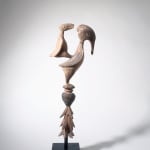Anonymous Baga artist
Early 20th century
Wood
height 20 7/8 in
Further images
While Guinea’s Baga peoples are especially known for their famous snake headdresses, which represented a divine serpent spirit who bestowed rain, fertility, and wealth onto the Baga people, they also created bird headdresses, worn in masquerades during coming-of-age ceremonies for young boys. They were referred to as ‘a-Bemp’ or ‘a-Bamp’, meaning ‘the bird’. The basic headdress is simply a bird form with a long neck, a long beak, a pot-bellied body, and broad striped wings over the back. Generally, a stake extends down from the belly, used to insert into an armature that the dancer wore on his head. Many of these a-Bemp headdresses have a miniature twin bird on their backs. As the birds stands on a vertical pole, elaborately decorated in the present example, this beautiful sculpture is not immediately recognizable as a headdress. Yet, a few known examples with their complete costume (for example in the collection of the Musée du quai Branly – inv. #71.1933.40.92) and field-photos of more recent masquerades confirm their use in such a setting, placed on top of a complex fiber structure covered with cloth. The a-Bamp headdress does not consistently represent any particular bird in nature. Many examples have head crests, suggesting the elegant large stalking birds of the sea inlets with their crowning tufts of feathers. The dance of the a-Bamp was athletic. The dance skipped around the perimeter of the circle formed by the audience. He crouched and then leaped up; or, crouching, he tilted to the right and left. Occasionally he could twirl, accelerating his steps, and ended by lifting the headdress above his head and spinning it around. Accompanying the dancer were men beating the large slit gong, box drums and smaller drums suspended under their arms. The dance generally took place at night, so a young man may followed a-Bamp with a torch made from a lit bundle of grass.
Provenance
Private Collection, France
Galerie Charles-Wesley Hourdé, Paris, France, 2019
Private Collection, France
Giquello, Paris, 8 November 2023, lot 148.
Duende Art Projects, Antwerp, Belgium, 2023
let's keep in touch
Join our community & never miss out on a DUENDE moment from now on
* denotes required fields
We will process the personal data you have supplied to communicate with you in accordance with our Privacy Policy. You can unsubscribe or change your preferences at any time by clicking the link in our emails.











